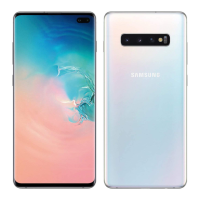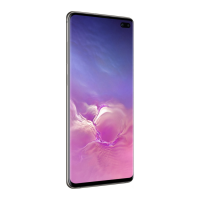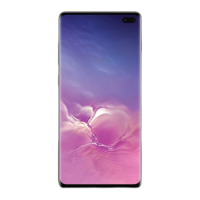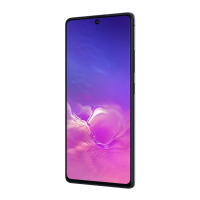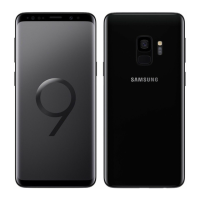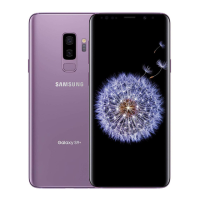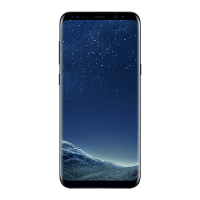Do you have a question about the Samsung Galaxy S10 and is the answer not in the manual?
Important introductory information for safe and proper device use.
Guidelines to maintain the device's water and dust resistance features.
Explains causes and solutions for device overheating during use or charging.
Advice on using the device in different environmental conditions to prevent damage.
Identifies and explains the physical components and their functions on the device.
Details the function of physical buttons like Power, Bixby, and Volume keys.
Explains the function of on-screen navigation buttons like Recents, Home, and Back.
Instructions on how to power the device on, off, and restart it.
Step-by-step guide for the initial configuration of the device after first use.
Information on creating, signing in, and managing a Samsung account.
Guide on using Smart Switch to transfer data from an old device to the new one.
Explains how to interact with the touchscreen using gestures like tapping and swiping.
Describes navigation between the Home screen and the Apps screen and customization.
Explains how the lock screen works and how to change screen lock methods.
Instructions on how to capture screenshots and edit them using various methods.
Details how to view and manage notifications and quick settings on the device.
Covers keyboard layout, changing languages, and additional text input functions.
Guidelines and precautions for charging the device's battery correctly.
Tips and settings to conserve battery power and extend device usage time.
Important advice and warnings related to battery charging and power management.
Explains the built-in fast charging feature and how to increase charging speed.
Details how to use the wireless charging coil and fast wireless charging feature.
Instructions on how to charge other devices using the phone's battery.
Step-by-step guide for inserting SIM or USIM cards into the device.
Illustrates the correct placement of Nano-SIM and microSD cards in the trays.
Procedure for safely removing the SIM or USIM card from the device.
Information on activating, customizing, and setting preferences for dual SIM cards.
Guidance on inserting a microSD card and file system compatibility.
Steps for safely removing a memory card after unmounting it.
Instructions on how to format a memory card for compatibility with the device.
How to download, install, and remove applications from the Galaxy Store and Play Store.
Guide on disabling, enabling, and managing app permissions for optimal device performance.
Introduction to Bixby, a voice assistant, and how to start using it.
Explains Bixby Vision features like image search, text translation, and AR experiences.
Details on viewing recommended content and customizing Bixby Home settings.
Instructions on creating and managing reminders using the Reminder app.
Guide on making and receiving voice and video calls, managing contacts, and call features.
How to add, import, sync, search, share, and manage contacts on the device.
Instructions for sending, viewing, and blocking messages using the Messages app.
Guide on browsing the web, bookmarking pages, and using secret mode for privacy.
Steps for setting up email accounts, sending, and reading emails.
Comprehensive guide on using the camera, including modes, settings, and shooting tips.
How to view, manage, and create movies, GIFs, or collages from media files.
Instructions on creating and using My Emoji, Character Emojis, and stickers.
How to customize and use the Always On Display feature for notifications and information.
Explains how to use Edge panels for quick access to apps and features.
Guide on running two apps simultaneously in split screen or pop-up view.
Information on setting up and making payments using Samsung Pay and NFC.
How to use Samsung Health to track fitness, manage wellness, and compete with friends.
Instructions on connecting and managing wearable devices with the Galaxy Wearable app.
Information on accessing support services, submitting reports, and viewing tips.
How to create, edit, and delete notes with text, drawings, and media.
Guide on creating and managing events, tasks, and reminders in the Calendar app.
Instructions on making, changing modes, and playing voice recordings.
How to access and manage files stored on the device or in cloud storage.
Guide on setting alarms, using the world clock, stopwatch, and timer.
Information on gathering games, setting performance modes, and using game tools.
How to set up and use Kids Home for a safe and controlled environment for children.
Connecting and controlling nearby devices, home appliances, and IoT products.
How to use the smartphone like a computer via an external display.
Overview of common Google applications like Chrome, Gmail, Maps, and YouTube.
Overview of device settings and customization options available.
Settings for Wi-Fi, Bluetooth, NFC, Mobile Hotspot, and other network features.
How to connect to Wi-Fi networks and use Wi-Fi Direct for direct device connections.
Pairing with Bluetooth devices, sending/receiving data, and dual audio features.
Using NFC for reading tags, making payments, and sending data wirelessly.
How to reduce mobile data usage by preventing background app data transfer.
Setting specific apps to always use mobile data, even when connected to Wi-Fi.
Managing SIM/USIM cards for calls, messages, mobile data, and dual SIM settings.
Instructions on using the device as a mobile hotspot to share internet connection.
Customizing settings for nearby device scanning, printing, MirrorLink, Download booster, VPN, etc.
Adjusting sound modes, ringtones, notification sounds, volume, and vibration settings.
Customizing notification settings, app icon badges, and Do Not Disturb mode.
Adjusting brightness, adaptive brightness, blue light filter, night mode, and screen resolution.
How to activate and schedule the blue light filter to reduce eye strain.
Enabling and scheduling night mode to reduce eye strain in low-light conditions.
Options to adjust display color balance and screen modes like Vivid and Natural.
Settings for screen lock type, Smart Lock, Always On Display, clock style, and notifications.
Setting the device to unlock automatically based on trusted locations or devices.
Settings for securing the device with face recognition, fingerprints, and other security options.
How to register and use face recognition for unlocking the screen and security.
Steps for registering and using fingerprints to unlock the device and for secure features.
Using Samsung Pass for autofill of login, personal, and payment information with biometrics.
How to set up and use Secure Folder to protect private content and apps.
Managing Samsung and Google accounts, backing up and restoring data via Samsung Cloud.
Syncing, backing up, and restoring device data using Samsung Cloud storage.
Configuring settings for Google features such as Google Assistant and Google Maps.
Enabling and configuring advanced features like Bixby Routines, Smart capture, and Motions and gestures.
Creating and using routines to automate device settings based on situations.
Activating and configuring motion-based gestures for device interaction.
Instructions on installing and using a second instance of messenger apps for dual accounts.
Monitoring device usage, setting app timers, and activating wind down mode.
Overview of device status, optimizing performance, and managing battery, storage, and memory.
Checking device security status, scanning for malware, and managing app security.
Managing installed apps, viewing usage, changing settings, and uninstalling.
Customizing system settings like language, date/time, and performing device resets.
Features to improve device usability for users with vision, hearing, or dexterity impairments.
How to activate, deactivate, and configure Voice Assistant for spoken feedback.
Settings to improve sound quality for hearing aids, adjust sound balance, and use mono audio.
Converting spoken voice into on-screen text for input and communication.
Options for controlling the device via gestures, switches, and assistive menus.
Solutions for common device issues like password prompts, network errors, and freezing.
Safety warnings and instructions regarding battery removal and service.
| Screen shape | Flat |
|---|---|
| Display diagonal | 6.4 \ |
| Touch technology | Multi-touch |
| Display resolution | 3040 x 1440 pixels |
| Rounded display corners | Yes |
| Display number of colors | 16 million colors |
| Processor cores | 8 |
| Processor family | Qualcomm Snapdragon |
| Processor frequency | 2.8 GHz |
| Processor lithography | 7 nm |
| RAM capacity | 8 GB |
| Compatible memory cards | MicroSD (TransFlash) |
| Maximum memory card size | 512 GB |
| Internal storage capacity | 128 GB |
| Rear camera type | Single camera |
| Rear camera resolution (numeric) | 12 MP |
| Front camera resolution (numeric) | 10 MP |
| Rear camera field of view (FOV) angle | 123 ° |
| Third rear camera resolution (numeric) | 16 MP |
| 4G standard | LTE |
| 2G standards | - |
| SIM card type | NanoSIM |
| Wi-Fi standards | 802.11a, 802.11b, 802.11g, Wi-Fi 4 (802.11n), Wi-Fi 5 (802.11ac), Wi-Fi 6 (802.11ax) |
| Bluetooth version | 5.0 |
| SIM card capability | Single SIM |
| Mobile network generation | 4G |
| Subscription type | No subscription |
| USB version | 2.0/3.2 Gen 1 (3.1 Gen 1) |
| Headphone connectivity | 3.5 mm |
| Multimedia Messaging Service (MMS) | Multimedia Messaging Service (MMS) is a standard way to send messages that include multimedia content to and from a mobile phone over a cellular network |
| Color name | Ceramic Black |
| Form factor | Bar |
| Product color | Black |
| Themes | Audio, Screensavers, Wallpapers |
| Personalization | Icons, Ringtones, Themes, Wallpaper, Widgets |
| FM radio | No |
| Supported video modes | 2160i |
| Audio formats supported | 3GA, AAC, AMR, APE, AWB, DSF, FLAC, MID, MIDI, MP3, MXMF, OGA, OGG, OTA, RTTTL, RTX, WAV, WMA, XMF |
| Video formats supported | 3G2, 3GP, ASF, AVI, FLV, M4V, MKV, MP4, WEBM, WMV |
| App distribution platform | Google Play |
| Operating system installed | Android 9.0 |
| Talk time (3G) | - h |
| Battery capacity | 4100 mAh |
| Depth | 7.6 mm |
|---|---|
| Width | 73.7 mm |
| Height | 162.6 mm |
| Weight | 173 g |
